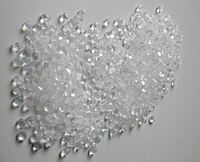
Photo from wikipedia
Stretchable electrodes are the more suitable for dielectric elastomer transducers (DET), the closer the mechanical characteristics of electrodes and elastomer are. Here, we present a solvent-free synthesis and processing of… Click to show full abstract
Stretchable electrodes are the more suitable for dielectric elastomer transducers (DET), the closer the mechanical characteristics of electrodes and elastomer are. Here, we present a solvent-free synthesis and processing of conductive composites with excellent electrical and mechanical properties for transducers. The composites are prepared by in-situ polymerization of cyclosiloxane monomers in the presence of graphene nanoplatelets. The low viscosity of the monomer allows for easy dispersion of the filler, eliminating the need for a solvent. After the polymerization, a cross-linking agent is added at room temperature, the composite is solvent-free screen-printed, and the cross-linking reaction is initiated by heating. The best material shows conductivity σ = 8.2 S∙cm-1 , Young's modulus Y10% = 167 kPa, and strain at break s = 305%. The electrode withstands large uniaxial strains without delamination, shows no conductivity losses during repeated operation for 500 000 cycles, and has an excellent recovery of electrical properties upon being stretched at strains of up to 180%. Reliable prototype capacitive sensors and stack actuators are manufactured by screen-printing the conductive composite on the dielectric film. Finally, stack actuators manufactured from dielectric and conductive materials that are synthesized solvent-free are demonstrated. The stack actuators even self-repair after a breakdown event. This article is protected by copyright. All rights reserved.
Journal Title: Macromolecular rapid communications
Year Published: 2022
Link to full text (if available)
Share on Social Media: Sign Up to like & get
recommendations!